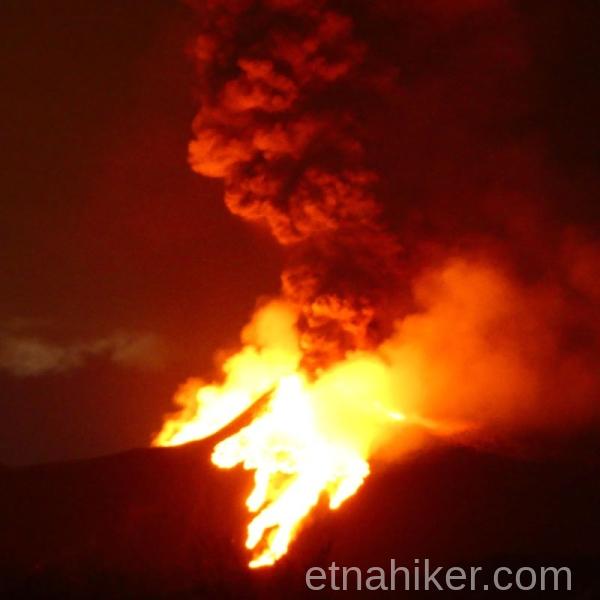Although it has always been considered by the people as a "Good Volcano" whose eruptive manifestations are mainly of an effusive nature, Etna has recorded an increase, in recent decades, of explosive eruptions from its Summit Craters, or perhaps today the easier documentation of such events, brings more and more to everyone's eyes, the dynamism of this giant.
When an ongoing volcanic activity becomes sudden and particularly violent, that is when in a relatively short interval of time considerable quantities of volcanic products are instantly emitted with extreme power, we use to speak of Volcanic Paroxysm.
Normally such a manifestation represents the extreme degree of evolution of an activity that has already begun in a moderate manner, but which can also be such from the beginning.
Paroxysms on Etna are characterized by strong explosive activity that varies from violent Strombolian explosions to lava fountains. This diversity in eruptive behavior is linked to the different mechanisms of magma ascent in the volcanic conduits that carry it towards the surface. These events can last from tens of minutes to a few hours and/or days, and generally give rise to high eruptive columns, even over 10 km above sea level, and to high emissions of Ash Clouds that disperse up to hundreds of km away from the volcano.
These products create no small inconvenience to local populations and to air, road and rail traffic. These events seem to be linked to transitory magmatic intrusions that feed them, showing all their power with the evidence already written. It is also important to know that each individual event provides increasingly updated data for understanding volcanic activity. It is important to classify volcanic eruptions with an "energy index" VEI - VOLCANIC EXPLOSIVENESS INDEX - represented by the quantity of products emitted, expressed in cubic meters. This index ranges from 0 to 8 and to understand how catastrophic a volcano can be in its manifestations, it is important to know that the eruption considered the most impressive of Etna in historical times, in 1669, had a VEI classification of 4. At the moment Etna is certainly not scary.
In Sicily there are various active volcanoes but, the two that stand out for their almost continuous eruptive activity, at least in recent periods, are certainly Etna and Stromboli. Both are open conduit volcanoes, they show a different activity in the chemistry of the events and the erupted products, a difference mainly linked to the different magmas that feed their respective activities, converging however on a similar eruptive dynamic linked to the same mechanisms of magma ascent in the conduit.
The paroxysmal sequences paroxysmal episodes produced by the Etna volcano fall within the typologies of “fluid magma” paroxysms, not to be confused with the same typology of activity also found on the Stromboli volcano, which fall within the typologies of “viscous magma paroxysm” so much so that the events recorded in Stromboli have a behavioral genesis different from Etna. I always remember that the Stromboli and ETNA volcanoes in Sicily are defined as open conduit volcanoes unlike other volcanoes in Sicily such as the island of Vulcano defined as closed conduit volcano. The paroxysmal sequences on Etna generally represent an entire “eruptive period”, and for this reason an alert system called ETNAS has been created which allows the use of the summit area of the Volcano carried out by Alpine and Volcanological Guides for the purpose of better risk mitigation.
The INGV (National Institute of Geophysics and Volcanology) is responsible for this, and in fact it carries out continuous monitoring of the volcano, which with specific instruments is able to prevent and communicate events of this kind to the workers who operate on the volcano in due time to provide for the evacuation of the summit area, which as indicated on the map consists of abandoning the area limited by the yellow line. It can undoubtedly be attested that Etna is well monitored by doctors and in good health even if bruised on one side, but we will talk about this later.
Insights
Photos of Etna's paroxysms
Video of Etna's paroxysms







